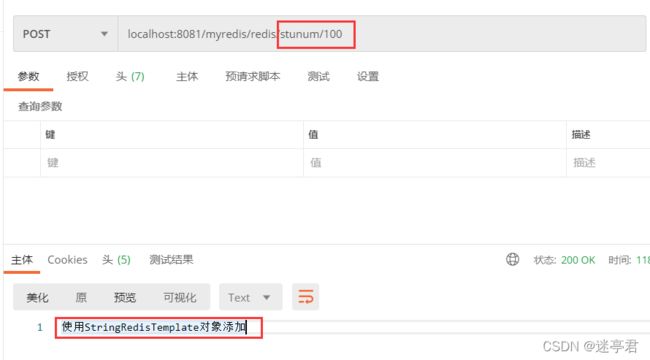springboot使用redis
redis-service.exe : 服务端,启动后不要关闭
redis-cli.exe : 客户端,访问redis中的数据
redisclient-win32.x86_64.2.0.jar : redis的图形界面客户端,执行方式是在这个文件的目录执行
java -jar redisclient-win32.x86_64.2.0.jar
或者在这个jar包的目录下点击即可直接执行
点击server,点击add,设置端口号就可以访问redis了
springboot使用redis步骤
添加依赖
redis起步依赖,导入后可以直接使用RedisTemplate
RedisTemplate实际上使用的是lettuce客户端库
org.springframework.boot spring-boot-starter-data-redis
在application.properties中配置redis连接
#指定redis信息 (如 host, ip, password) spring.redis.host=localhost spring.redis.port=6379 #没有密码可以不用配置这个 #spring.redis.password=123456
使用redisTemplate来访问redis服务器
import org.springframework.data.redis.core.RedisTemplate;
import org.springframework.data.redis.core.StringRedisTemplate;
import org.springframework.data.redis.core.ValueOperations;
import org.springframework.web.bind.annotation.GetMapping;
import org.springframework.web.bind.annotation.PathVariable;
import org.springframework.web.bind.annotation.PostMapping;
import org.springframework.web.bind.annotation.RestController;
import javax.annotation.Resource;
@RestController
public class RedisController {
/**
* 需要注入redis模板
*
* 对于RedisTemplate的泛型情况,
* 可以使用
*
* 或者不写泛型
*
* 注意,属性的名称必须为redisTemplate,因为按名称注入,框架创建的对象就是这个名字的
*/
@Resource
private RedisTemplate redisTemplate;
@Resource
private StringRedisTemplate stringRedisTemplate;
// 添加数据到redis
@PostMapping("/redis/addstring")
public String addToRedis(String name, String value) {
// 操作Redis中的string类型的数据,先获取ValueOperation
ValueOperations valueOperations = redisTemplate.opsForValue();
// 添加数据到redis
valueOperations.set(name, value);
return "向redis添加string类型的数据";
}
// 从redis获取数据
@GetMapping("/redis/getk")
public String getData(String key) {
ValueOperations valueOperations = redisTemplate.opsForValue();
Object v = valueOperations.get(key);
return "key是" + key + ",它的值是:" + v;
}
@PostMapping("/redis/{k}/{v}")
public String addStringKV(@PathVariable String k,
@PathVariable String v) {
// 使用StringRedisTemplate对象
stringRedisTemplate.opsForValue().set(k,v);
return "使用StringRedisTemplate对象添加";
}
@GetMapping("/redis/{k}")
public String getStringValue(@PathVariable String k) {
// 获取String类型的value
String v = stringRedisTemplate.opsForValue().get(k);
return "从redis中通过" + k + "获取到string类型的v=" + v;
}
}
redisTemplate对象有好几种,上面代码中给了两种
一种为RedisTemplate,这种是有泛型的,泛型类型为
使用postman
明明存入成功了,在redis中查询的时候是带有乱码前缀的
![]()
直接通过"lisi"它的值是可以取出的
可见在RedisTemplate在存取中做了手脚.
当我们使用StringRedisTemplate对象存取String类型的数据时,是没有乱码的
存
取
redis服务器中的数据
数据正常展示
StringRedisTemplate和RedisTemplate
上面说到了这两者在存取中的差异
- StringRedisTemplate : 这个类将key和value都做String处理,使用的是String的序列化,可读性好
- RedisTemplate : 把key和value经过了序列化,key和value都是序列化的内容,不能直接识别,默认使用的是JDK的序列化,可以修改为其他的序列化
序列化作用 :
序列化是将对象转换为可传输字节序列的过程,反序列化是将字节序列还原为原对象的过程.序列化最终的目的是为了对象可以跨平台存储和进行网络的传输
序列化的方式 :
序列化只是一种拆装对象的规则,那么这种规则也就多种多样,常见的有JDK(不支持跨语言),json,xml,Hessian等
我们上面的RedisTemplate类的存储就是JDK方式的
jdk方式的序列化
java的序列化 : 把java对象转换为byte[],二进制数据
json序列化 : json序列化功能将对象转换为json格式或者将其转换回对象,如Student对象转换为{“name”:“张三”,“age”:“20”}
序列化的方式可以改变
/** 设置RedisTemplate序列化机制
* 可以设置 key 的序列化,也可以设置 value 的序列化
* 也可以同时设置
*/
@PostMapping("/redis/addstr")
public String addString(String k, String v) {
// 设置RedisTemplate的序列化机制
// 设置key为string类型的序列化
redisTemplate.setKeySerializer(new StringRedisSerializer());
// 设置value的序列化
redisTemplate.setValueSerializer(new StringRedisSerializer());
redisTemplate.opsForValue().set(k, v);
return "添加了k和v";
}
使用json方式的序列化
创建实体类,需要实现序列化接口,最好有序列化的UID
import java.io.Serializable;
public class Student implements Serializable {
private static final long serialVersionUID = -7839813688155519106L;
private Integer id;
private String name;
private Integer age;
public Integer getId() {
return id;
}
public void setId(Integer id) {
this.id = id;
}
public String getName() {
return name;
}
public void setName(String name) {
this.name = name;
}
public Integer getAge() {
return age;
}
public void setAge(Integer age) {
this.age = age;
}
}
idea生成序列化UID的方式,需要先在setting中开启,如下
然后将光标放在类名上,alt+enter
在方法中设置序列化方式
/**
* 使用json序列化
*/
@PostMapping("/redis/addjson")
public String addJson() {
Student student = new Student();
student.setName("zhangsan");
student.setAge(20);
student.setId(1);
// 设置key为string的序列化方式
redisTemplate.setKeySerializer(new StringRedisSerializer());
// 设置value为json的序列化方式,json为Student类型的方式组织,所以需要传入Student.class
redisTemplate.setValueSerializer(new Jackson2JsonRedisSerializer(Student.class));
redisTemplate.opsForValue().set("myStudent", student);
return "存入json类型的数据student";
}
测试访问url
在redis服务端检查数据
果然,数据的value已经以json的方式存入内存中了.
使用json的方式反序列化将数据取出
/**
* 使用json序列化
*/
@PostMapping("/redis/addjson")
public String addJson() {
Student student = new Student();
student.setName("zhangsan");
student.setAge(20);
student.setId(1);
// 设置key为string的序列化方式
redisTemplate.setKeySerializer(new StringRedisSerializer());
// 设置value为json的序列化方式,json为Student类型的方式组织,所以需要传入Student.class
redisTemplate.setValueSerializer(new Jackson2JsonRedisSerializer(Student.class));
redisTemplate.opsForValue().set("myStudent", student);
return "存入json类型的数据student";
}
反序列化的时候必须得指定序列化的方式,要不然不能取出数据
总结
到此这篇关于springboot使用redis的文章就介绍到这了,更多相关springboot使用redis内容请搜索脚本之家以前的文章或继续浏览下面的相关文章希望大家以后多多支持脚本之家!
















